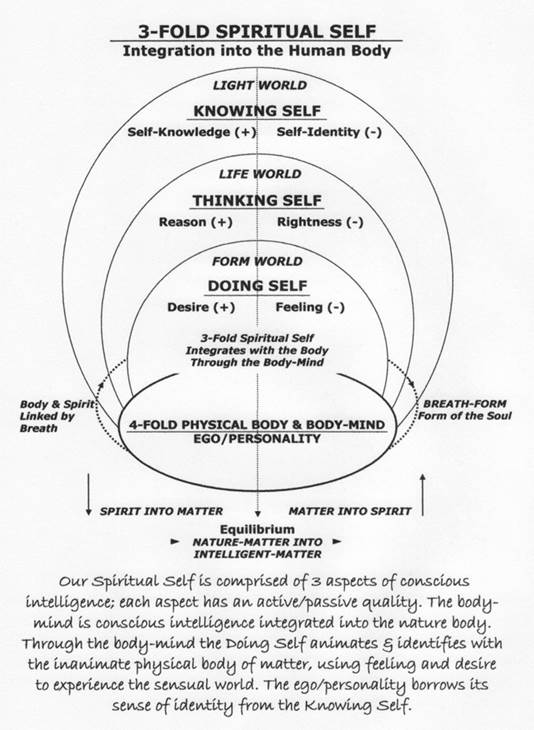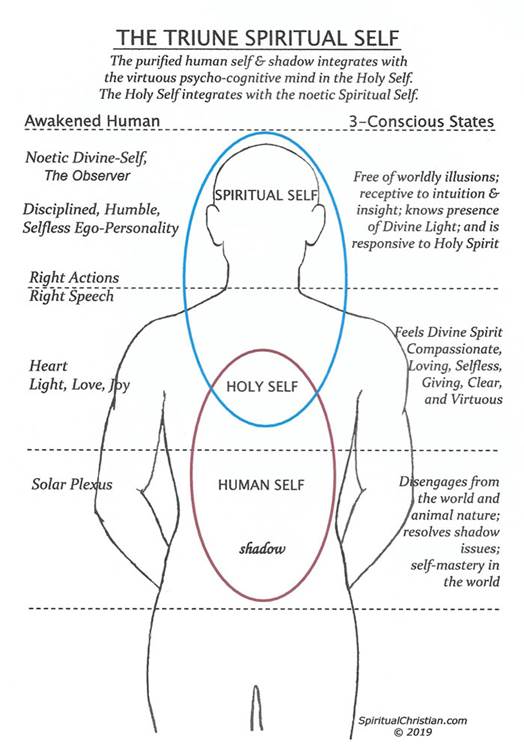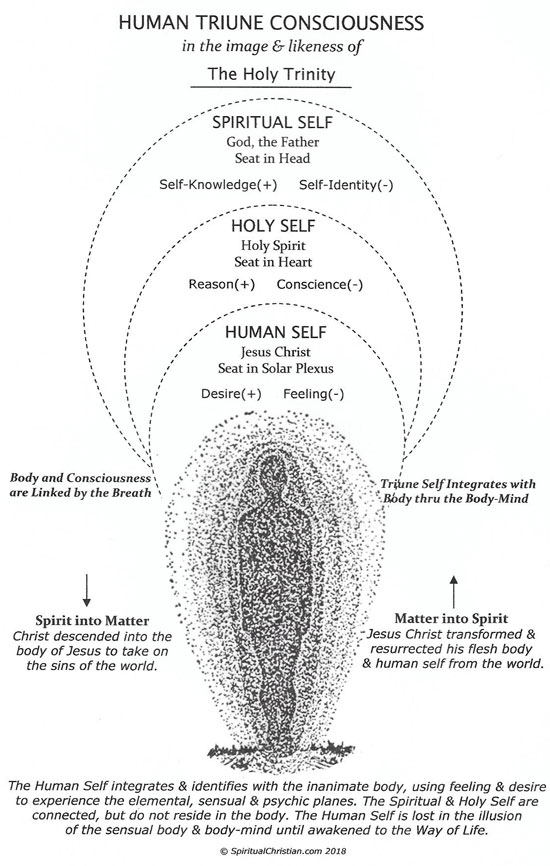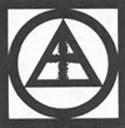PROJECTING EGO IN THE WORLDLY ILLUSION
Although God, the Father is Spirit, God has a consciousness of self, and a beingness or Divine nature; this union of self-identity and beingness is the personal consciousness of Divine Life in Itself. The union between self-identity and beingness is proper to both the Divine Spirit and the human spirit, although there are distinguishing differences between the two. In God, there is a triune or trinitarian spirit. A trinitarian spirit means the union of three distinct personalities into one person. In the Holy Trinity, there are three distinct personalities which are united as one Divine Being in the person of Jesus Christ.
Humans are created in the image and likeness of God with a triune
self. This means humans have a singular spirit with three distinct expressions of consciousness in one personality or one triune self: the Knower, Thinker, and Doer respectively or the spiritual self, the holy self, and the human self. (See: diagrams below) Our triune self reflects the Holy Trinity’s triune spirit. (diagram at bottom) Although the human is configured as a triune self, there is a significant, yet revealing difference, between the Divine Trinity and the human person in regard to the personal principles existing in both.


SpiritualChristian.com
In the Divine Being, the Holy Trinity, there is nothing which exists in an unrealized state as everything is totally and completely transparent to Itself and within Itself. Thus, there is no space in the life of Divinity for unconsciousness or even super-consciousness. God’s nature is a personal triune Self-Realization which is one nature of the Father and of the Son and of the Holy Spirit, with each hypostasis (any person of the Holy Trinity) having divinity in its own way, for itself, and for the other hypostases within the Trinity.
That being said, the principle nature of Divinity in the Holy Trinity is God, the Father; He has His own nature, and His possession of His nature expresses as a hypostatic, co-hypostatic, and interhypostatic union. In the trihypostatic spirit of the Trinity, all the modes of the personal principles
are united within the one Divine Person: I, thou, he, we, and you.
The distinguishing and challenging characteristic in the life experience of humans is that all the modes of the personal principles, except the I, exist outside of themselves; these different modes are perceived in other people. This reality of life for humanity means we unconsciously project onto other people our psychic energies as individual: perceptions, imaginations, prejudices, and biases; creating limitations, misperceptions, and boundaries in our life experience because we perceive that other people feel differently than we do.
Consequently, when we interact with people, we unconsciously project our biased and often flawed perceptions, expectations, insecurities, anxieties, etc. onto others, thus generating reciprocating feelings, animosity, and/or attitudes from other personalities which, favorably or adversely, affect our own feelings and our beingness. (See: Being and Soul) Our unconscious psychic projections are biased because we are not conscious of these undeveloped aspects of our personality. (See: The Shadow)
The responses we experience from other personalities force us out of our ego-persona, making us confront these unconscious fragments of personality, as we attempt to resolve or appease their reactions to our projections. Such confrontations help us to unify and understand these fragments of our unconscious-self in hopes of creating harmonious relationships with others.
The Ego-Persona & Duality
In contrast to the spiritual essence of our Divine-Self, which is transparent and not connected to the world, our human creaturely-I, the ego-persona, is totally identified with the instinctual impulses and desires of the creaturely body and is seamlessly connected to the worldly illusion. In adolescence, personal self-awareness awakens and the ego-persona immediately forms a perception of the physical body as being separate from all other bodies, that is, the ego-persona is inside the bodily form and everyone else is outside.
From this perception of separation, a semi-conscious boundary is created which distinguishes “our I” from all other “I’s” which we perceive as “I and not-I’s.” Thus, we are trapped in the experience of duality as a result of the boundaries we create between ourselves and everyone and everything in the world. Self-realization for the ego-persona requires the play of light and shadow; the rays of reality must be reflected from a fixed position which is its boundary. In the boundary reality of the world, the ego-persona requires the reality of the “not-I other” in order to realize itself as an I.
Only the Divine Person, the Holy Trinity, is free and absolute so the I and Thou are contained in one Trinitarian Person, Jesus Christ. This Divine Person has Himself wholly in Himself, and He does not require a co-I outside Himself to realize Himself. Therefore, His autonomous being (and freedom) is sufficient unto itself.
The ego-persona is aware of people, events, or objects in the world because it establishes a contrasting relational perception, like seeing a bright star on a dark night. For the personal self-consciousness, boundary awareness means we must have two correlative aspects in order to discern reality, such as my ego and another different ego. In a given situation, people will unconsciously draw a boundary-line which defines where they currently stand and how they feel about other males, other females, a particular reality, or where they will take a moral stand; and they will establish a boundary-line between any opposing principles. Remember, a boundary-line can also be a battle line.
The tendency of humans is to separate the opposites and then cling to the positive aspects while rejecting the negative; but the reality is, we can’t have one exclusively without the other. It is the interplay of the opposites within reality or a perception of reality which reveals the truth of who we really are and where we stand. Naturally, trying to reconcile the dualities in life becomes very frustrating for anyone who is still asking the question, “Who am I?”
In an effort to grasp a sense of identity, wholeness and peace within, we humans consciously and unconsciously establish boundaries between our ego-centric bodily-I and all the people and things in the worldly illusion which we deem as not-I. This psychological separation pushes all not-I’s away from our conscious self because we are unable to understand and integrate all that comprises the worldly not-I; thus, we often feel alienated from people in the world.
In the daily interplay with other ego-personalities, our ego-persona accumulates and reacts to all these new experiences of life in the worldly illusion. Many of these interactions and experiences with others are confusing, incomplete or hurtful; thus, we push this content into our personal unconsciousness. The personal unconscious is active content from which possibilities are ceaselessly becoming actualities; that is, our personal unconscious emotional experiences continuously react and generate new experiences in life whether we realize it or not. The ego-persona bears these experiences which are not transparent to it and not fully knowable because of their unconscious origins. This is why we often get into situations we least desire, but most need.
In its daily interactions with other egos of the world, the ego-persona experiences personal perceptions, feelings, desires and emotions. This action of the ego-persona creates personal content, some of which the conscious-self does not want to deal with. These emotionally charged issues and unresolved experiences, like: hurt feelings, grudges, childhood trauma, inadequacies, guilt, shame, fear and anger get stuffed down and repressed in the personal unconscious to be dealt with later; this is our personal unconsciousness, the shadow, which is within the lower psychic of the body-mind. (See: Thinking, the Body-Mind and Self-Perception)
The majority of the content in the unconscious shadow is from our projecting unrealistic expectations onto others and experiencing disappointment, anger and hurt feelings, like when our parents, siblings, friends, lovers, co-workers, and situations do not live up to our expectations. The ego-persona is not only revealed through the shadow but is also limited by it.
In this sense, the personal unconscious remains hidden and unknown regarding itself; it does not exhaust itself but is in the process of becoming itself. Thus, the personal unconscious or shadow self is the obstacle which hinders the human triune self from being transparent and divine in the manner of the Holy Trinity. The troubling issues in the unconscious shadow can be made conscious and systematically resolved and dissolved through the stages of meditation presented on this site. (See: A Brief Overview of Meditation)
Creaturely-I & the Divine-I
The life, resurrection and ascension of Jesus Christ, the God-man, clearly demonstrated that humans are both creaturely and divine. The human creaturely body is an instinctual animal body created to function like all other instinctual animals in the world. However, what distinguishes the human being from the rest of creation is the divine essence the Creator breathed into the image and likeness matrix of the human form, the male/female Adamic body.
In the dualities of Creation, this spiritual essence is our spiritual light and breath; it is active consciousness as Self-Knowledge which is the knowledge and presence of the divine light, and it is passive consciousness as Self-Identity which is the knowing and presence of our true Identity, our divine God-Self. This Divine Self-Knowing Identity IS our true Self, our God-Self, which is an ever-present light in the center of our heart and in the center of our brain. In a fully conscious, Self-realized and enlightened being, like Jesus Christ and Mother Mary, this is the center from which the Light of God radiates as a halo.
The diagram below of the human triune self also represents the image and likeness of the Holy Trinity; and this triune self can also become whole, autonomous, and sufficient unto itself. When the fragments of the personal unconscious are liberated from the darkness of non-being and brought into the light, they can then be integrated back into the personal triune self in a process of incrementally becoming whole. The most proficient method of achieving wholeness is through the systematic stages of meditation explained on this site.
In particular, Stage 2 Meditation specifically explains how to redeem the shadow and achieve wholeness of being by making the unconscious shadow conscious and by purifying the psychological nature through focused meditation. The triune self-consciousness of humans is not meant to remain separate and isolated in itself, and neither is it meant to remain unconsciously projected onto others and the world. Like the saying states, “The soul redeemed by obedience to the Divine Will, withdraws itself, and aspires evermore to its center, until absorbed therein, it becomes like unto God, wholy spiritual.” As we progress to our center we rise above the temptations of the world, like Christ; and we rise above the illusions of the world and experience union with real Life; this is an important step in the spiritual quest.
The human triune self is ego-centric, that is, it is the center of self-affirmation and of self-repulsion; this is the reason we experience dualities. However, in order to reorient itself, the triune self must begin a process of dynamic self-realization. What this means is the triune self, through consistent and successful meditation practice, will be still, focused and centered, and will begin to recognize the I from the not-I. When the fragments of the unconscious shadow are recognized, they become conscious and can be integrated and internalized into the “I” of the triune self.
As this process continues, one can eventually integrate the unconscious fragments of the personal consciousness so these modes of the personal principle become internalized and one becomes a whole Self; similar to the Trihypostatic Personality of God. The Holy Trinity as a personality is precisely such a dynamic personal principle, thus, one can say, the Divine Spirit does not formally differ from the human spirit. “I have said, Ye are gods; and all of you are children of the most High.” (Psalm 82:6)

CHEERS
The story of one I looking at one YOU,
Is the story of two I's looking at two YOU's,
Until one I looks for the I in the other YOU;
Then two YOU's see I to I and One to One.
It's been that way since the world was begun.
SpiritualChristian.com

*
* *

